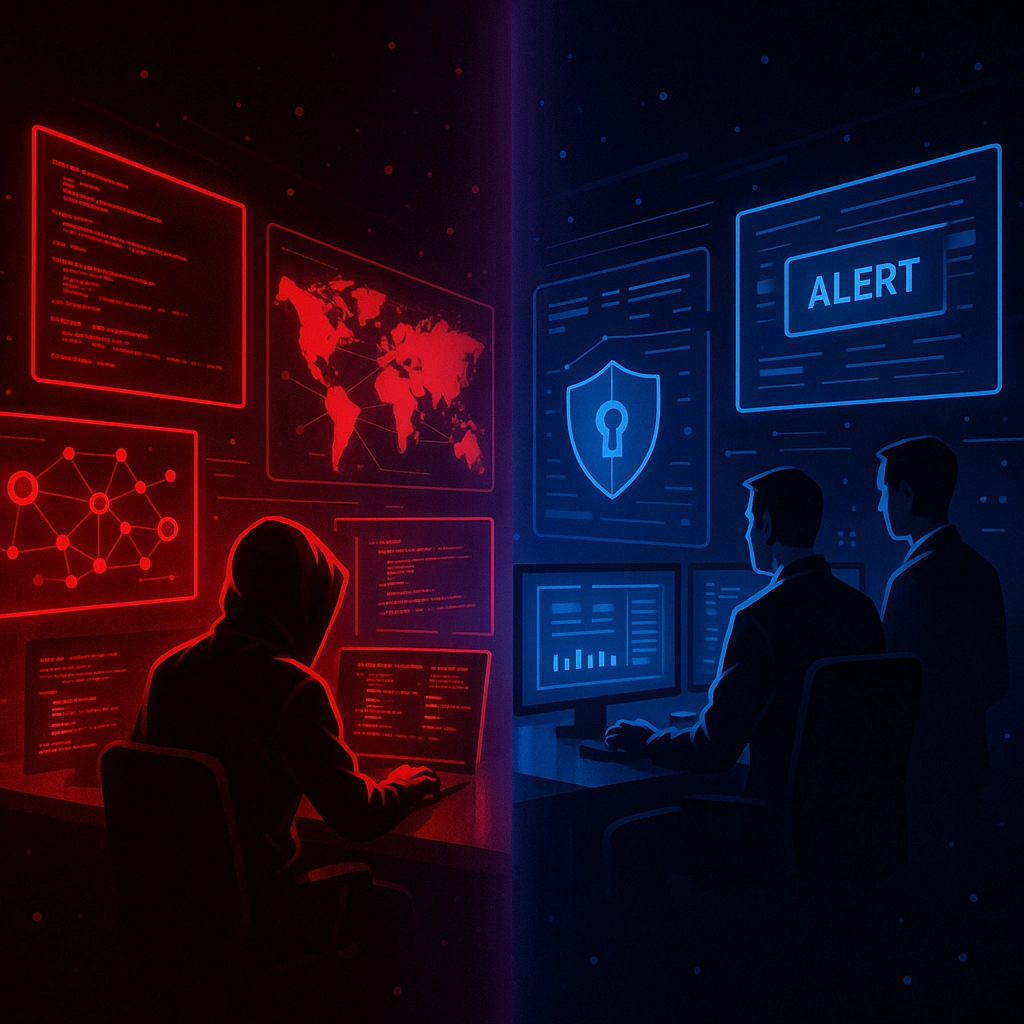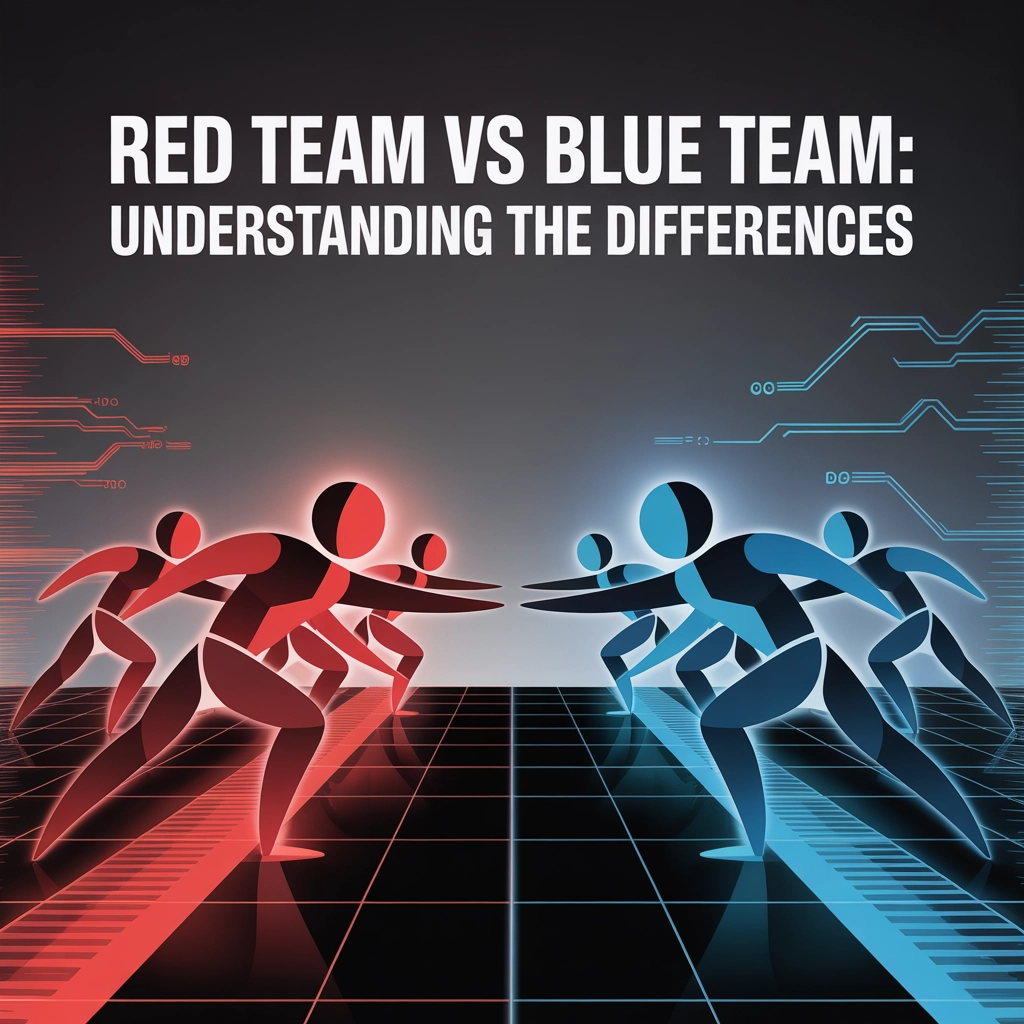In the constantly evolving world of cybersecurity, organisations need sophisticated approaches to protect their digital assets. Two essential components of a mature security strategy are Red Teams and Blue Teams. While they may sound like opposing forces in a military exercise, they actually represent complementary approaches to cybersecurity that, when implemented effectively, create a robust security posture. At EJN Labs, we've seen firsthand how understanding these distinct yet interconnected roles can transform an organisation's security strategy.
The Fundamentals: What Are Red and Blue Teams?
Red Team: The Ethical Attackers
A Red Team operates as an independent group of security professionals who simulate real-world attacks against an organisation's defences. They think, act, and utilise the same tools and techniques as genuine threat actors. The key difference? Their attacks are authorised, controlled, and designed to identify vulnerabilities before malicious hackers can exploit them.
Red Teams adopt an adversarial mindset and approach security testing from an outsider's perspective. They typically have no prior knowledge of the target environment and must gather intelligence through reconnaissance, just as actual attackers would. This approach, often called "black box testing," provides the most realistic assessment of an organisation's security posture.
Blue Team: The Defenders
The Blue Team consists of security professionals responsible for defending an organisation's digital assets against all threats. Unlike Red Teams, Blue Teams operate internally and are primarily focused on protection, detection, and response. They implement security controls, monitor systems for suspicious activities, and respond to security incidents.
Blue Teams take a proactive approach to security, constantly analysing the threat landscape and adapting defences to counter evolving threats. They are the guardians of an organisation's digital realm, working tirelessly to ensure that systems remain secure and operational.

Core Responsibilities: Red Team vs Blue Team
Red Team Responsibilities
- Penetration Testing: Red Teams conduct thorough penetration tests to identify and exploit vulnerabilities in systems, networks, and applications. These tests go beyond automated scanning to include exploitation of discovered weaknesses.
- Social Engineering: They test human elements of security through phishing campaigns, pretexting, and other social engineering techniques to assess employee awareness and response to manipulation attempts.
- Physical Security Testing: Red Teams may attempt to gain unauthorised physical access to facilities to test physical security controls and procedures.
- Threat Emulation: They mimic the tactics, techniques, and procedures (TTPs) of specific threat actors that might target the organisation, providing insight into how well the organisation would fare against such attacks.
- Evasion Techniques: Red Teams employ sophisticated evasion techniques to bypass security controls and detection mechanisms, revealing blind spots in the organisation's security monitoring.
Blue Team Responsibilities
- Security Monitoring: Blue Teams implement and manage security information and event management (SIEM) systems to monitor networks and systems for suspicious activities.
- Incident Response: They develop and execute incident response plans to address security breaches and minimise damage when incidents occur.
- Threat Hunting: Blue Teams proactively search for indicators of compromise that may have evaded automated detection systems.
- Security Architecture: They design and implement robust security architectures that incorporate multiple layers of defence to protect critical assets.
- Security Policy Management: Blue Teams develop, enforce, and update security policies and procedures to ensure compliance with industry regulations and best practices.
Key Differences Between Red and Blue Teams
Perspective and Approach
The fundamental difference between Red and Blue Teams lies in their perspective. Red Teams adopt an attacker's mindset, constantly looking for weaknesses to exploit. They ask, "How can I break in?" In contrast, Blue Teams think like defenders, focusing on strengthening security controls. Their question is, "How can I keep attackers out?"
This difference in perspective leads to distinct approaches. Red Teams are offensive and aggressive, using their creativity to find novel attack vectors. Blue Teams are defensive and methodical, implementing comprehensive security measures to protect against known and unknown threats.
Tools and Techniques
Red Teams and Blue Teams utilise different tools and techniques to achieve their objectives:
| Red Team Tools | Blue Team Tools |
|---|---|
| Penetration testing frameworks (e.g., Metasploit) | SIEM solutions |
| Vulnerability scanners | Intrusion detection/prevention systems |
| Social engineering toolkits | Endpoint protection platforms |
| Custom exploit development | Network monitoring tools |
| Password cracking utilities | Threat intelligence platforms |
Red Teams often develop custom tools or modify existing ones to evade detection, while Blue Teams rely on commercial and open-source security solutions for protection and monitoring.

Metrics of Success
Success looks different for Red and Blue Teams. A Red Team succeeds when it can compromise systems, access sensitive data, or achieve specific objectives without detection. Their goal is to find vulnerabilities and demonstrate their potential impact.
For Blue Teams, success means preventing breaches, detecting attacks quickly, and responding effectively to incidents. They measure success through metrics like mean time to detect (MTTD) and mean time to respond (MTTR), as well as the effectiveness of their security controls in preventing attacks.
The Purple Team Concept: Bridging the Gap
The term "Purple Team" has emerged to describe the integration of Red and Blue Team functions. Rather than operating in isolation, Purple Team exercises involve collaboration between offensive and defensive security professionals to maximise learning and improvement.
In a Purple Team exercise, Red Team members execute attacks while simultaneously sharing information with Blue Team members about their tactics and techniques. This real-time feedback loop allows the Blue Team to adjust their defences and detection capabilities on the fly, creating a more dynamic and educational experience.
The benefits of this collaborative approach include:
- Accelerated Learning: Blue Teams learn directly from Red Team expertise, understanding attack techniques in detail.
- Immediate Improvement: Security defences can be enhanced in real-time based on Red Team findings.
- Shared Understanding: Both teams develop a better appreciation for each other's challenges and perspectives.
- Efficient Resource Use: By combining efforts, organisations can make better use of limited security resources.
At EJN Labs, we've found that organisations that embrace the Purple Team concept often achieve greater security maturity more quickly than those that maintain strict separation between offensive and defensive functions.

Real-World Applications: When to Use Red and Blue Teams
Red Team Engagements
Red Team exercises are particularly valuable in several scenarios:
- Security Maturity Assessment: For organisations with established security programmes that want to test their effectiveness against sophisticated threats.
- Compliance Requirements: When regulatory frameworks require comprehensive security testing beyond basic vulnerability scanning.
- New Threat Simulation: To understand how emerging threats might impact the organisation's security posture.
- Security Awareness Evaluation: To assess how well employees recognise and respond to social engineering attempts.
Red Team engagements should be scheduled periodically (usually annually) to provide a realistic assessment of the organisation's security defences. They require careful planning and clear scope definition to ensure they provide value without causing operational disruption.
Blue Team Operations
Blue Team functions should be integrated into daily security operations:
- Continuous Monitoring: Implementing 24/7 monitoring of security events and alerts.
- Regular Vulnerability Management: Identifying and remediating vulnerabilities before they can be exploited.
- Incident Response Planning: Developing and testing plans for responding to security incidents.
- Security Control Implementation: Deploying and maintaining security controls to protect critical assets.
Unlike Red Team engagements, Blue Team operations are ongoing and form the backbone of an organisation's security programme.
Building Effective Red and Blue Teams
Skill Sets and Training
Effective Red Team members typically possess:
- Advanced penetration testing skills
- Knowledge of multiple operating systems and platforms
- Programming and scripting abilities
- Creative problem-solving aptitude
- Understanding of network protocols and infrastructure
Blue Team members benefit from:
- Strong analytical skills
- Deep knowledge of security controls and technologies
- Incident response experience
- Familiarity with security frameworks and compliance requirements
- System administration and network engineering background
Both teams require continuous training to stay current with evolving threats and technologies. Certifications like OSCP (Offensive Security Certified Professional) for Red Teams and SANS GIAC certifications for Blue Teams provide valuable knowledge and industry recognition.
Team Structure and Collaboration
In larger organisations, Red and Blue Teams may exist as separate departments with distinct reporting lines. In smaller organisations, security professionals may wear multiple hats, performing both offensive and defensive functions as needed.
Regardless of structure, establishing clear communication channels between teams is essential. Regular meetings, shared documentation, and collaborative tools can help bridge the gap between offensive and defensive security functions.
Conclusion: The Power of the Red and Blue Team Dynamic
The relationship between Red and Blue Teams exemplifies the principle that security is not a destination but a journey. By continuously testing defences (Red Team) and improving protections (Blue Team), organisations create a dynamic security posture that evolves with the threat landscape.
At EJN Labs, we've witnessed how organisations that embrace both perspectives, the attacker's creativity and the defender's vigilance, build more resilient security programmes. The tension between Red and Blue Teams isn't a drawback; it's a feature that drives continuous improvement.
Whether you're building an internal security team or engaging external security partners, understanding these distinct yet complementary roles is essential for developing a mature cybersecurity strategy. By leveraging the strengths of both approaches, you can transform security from a necessary cost into a competitive advantage in today's digital landscape.
For more information about how EJN Labs can help you implement effective Red and Blue Team strategies, visit our website or explore our resources on penetration testing.











Leave a Reply